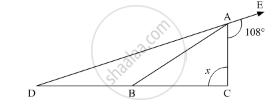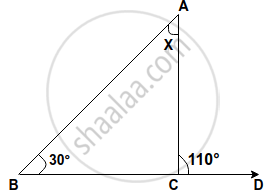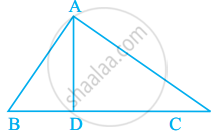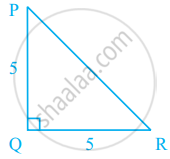Advertisements
Advertisements
प्रश्न
The angles of a triangle are arranged in ascending order of magnitude. If the difference
between two consecutive angles is 10°, find the three angles.
उत्तर
Given that,
The difference between two consecutive angles is `10^@`
Let x,x+10,x+20 be the consecutive angles differ by `10^@`
W.K.T sum of all angles of traingle is `180^@`
`x+x+10+x+20=180^@`
`3x+30=180^@`
⇒ `3x=180-30^@ ⇒ 3x=150^@`
⇒`x=50^@`
∴ `x=50^@`
∴ The required angles are
x,x+10 and x+20
x=50
x+10=50+10=60
x+20=50+10+10=70
The difference between two consecutive angles is `10^@` then three angles are ` 50^@,60^@ and 70^@`
APPEARS IN
संबंधित प्रश्न
In the given figure, AB divides ∠DAC in the ratio 1 : 3 and AB = DB. Determine the value of x.

Calculate the angles of a triangle if they are in the ratio 4: 5: 6.
The angle of a vertex of an isosceles triangle is 100°. Find its base angles.
Find x, if the angles of a triangle is:
2x°, 4x°, 6x°
In ∆ABC, C = 56° C = 56° ∠B = ∠C and ∠A = 100° ; find ∠B.
Find, giving a reason, the unknown marked angles, in a triangle drawn below:

Bisectors of the angles B and C of an isosceles triangle with AB = AC intersect each other at O. BO is produced to a point M. Prove that ∠MOC = ∠ABC.
In figure, ∠BAC = 90° and AD ⊥ BC. The number of right triangles in the figure is ______.
In figure, PQ ⊥ RQ, PQ = 5 cm and QR = 5 cm. Then ∆PQR is ______.
Can we have two acute angles whose sum is a straight angle? Why or why not?
